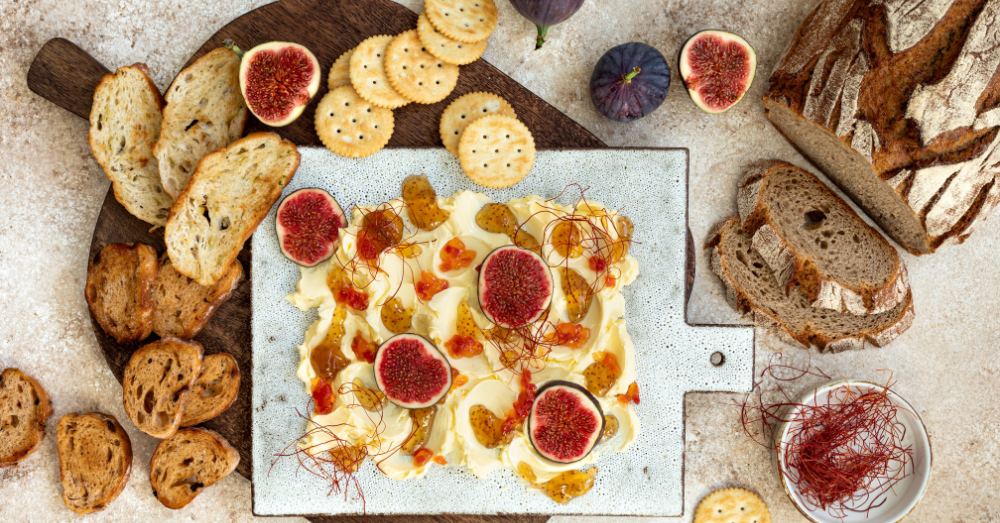You know that moment when you’re mindlessly scrolling TikTok and something stops you dead in your tracks? For millions of people in 2024, that moment came when they watched someone slather butter directly onto a wooden cutting board, sprinkle it with herbs, and call it dinner. Your brain probably did that thing where it goes “wait, what?” followed immediately by “but actually…”
- Butter boards grabbed nearly 1 billion views in 2024, becoming one of the year’s most talked-about food trends
- These shared appetizers cost way less than fancy charcuterie spreads while giving you endless ways to get creative
- Critics worry about germs and wonder why we can’t just use bowls, but fans love the hands-on experience
Welcome to butter boards, the food trend that made everyone pick a side.
How Butter on Wood Became Internet Gold
Here’s something wild – butter boards didn’t actually start on TikTok. Chef Joshua McFadden wrote about them in his 2017 cookbook “Six Seasons,” describing how he’d make them while working on a Maine farm to stretch fresh crab for more people. Smart guy, zero internet fame.
Fast forward to 2022, when Justine Doiron (@justine_snacks) posted her version on TikTok. The video exploded. We’re talking millions of views, thousands of recreations, and suddenly everyone’s grandmother was asking what a butter board was.
By 2024, the hashtag had racked up 950 million views, making it the second biggest food trend of the year. Not bad for glorified bread and butter.
Why People Went Absolutely Wild for This
Look, I get the initial confusion. Smearing butter on wood sounds like something you’d do if you ran out of plates. But there’s method to the madness.
First, money talks. Have you priced a decent charcuterie board lately? Between fancy cheeses, cured meats, and those little cornichon pickles that cost more per pound than beef, you’re looking at serious cash. A butter board? Grab some good butter, raid your herb garden, and you’re done for under twenty bucks.
Second, they’re dummy-proof. No stress about meat placement or cheese ratios. Spread butter, add pretty things, serve bread. Even your most kitchen-challenged friend can nail this.
But here’s what really hooked people – we were all starving for shared experiences after years of pandemic isolation. There’s something primal about everyone dipping bread into the same spread. It feels communal in a way that individual plates don’t.
The Haters Came Out Swinging
Of course, the internet being the internet, not everyone was ready to butter up to this trend. Twitter exploded with hot takes ranging from “disgusting” to “why can’t you just use a bowl?”
Food safety experts like Darin Detwiler raised legitimate concerns about wooden boards harboring bacteria in cracks and scratches. His advice? Use non-porous boards and proper serving utensils. Fair enough.
Others questioned the whole concept. “This is just an excuse to be messy,” one viral tweet complained. Celebrity chef reactions ranged from eye-rolls to outright mockery.
The hygiene thing is real – sharing butter from a communal board does hit different than individual servings. Some people just aren’t built for communal eating, and that’s okay.
When Butter Boards Got Weird
Once people mastered the original, creativity went off the rails. Cream cheese boards made sense – same concept, easier to spread, pairs beautifully with bagels and lox.
Hummus boards? Actually genius. Mediterranean toppings, pita chips, way more flavor than plain butter.
Then things got unhinged. People started making boards with Nutella, mashed avocado, ricotta-pesto combos, and even frosting. Drag queen Kim Chi summed it up perfectly on Twitter: “I’ve seen taco board, rice board, ice cream board, etc. I think it’s time to stop!”
Some trends know when to quit. Others just keep going until someone makes a board out of ketchup.
Actually Making One That Doesn’t Suck
If you’re ready to try this, here’s how to avoid disaster:
Get the butter right. Room temperature is your friend. Not fridge-hard, not melted mess. About 30 minutes on the counter should do it. Kerrygold or similar European-style butter makes a real difference here.
Master the smear. Use the back of a spoon or offset spatula to create waves in the butter. Think cake frosting techniques – you want texture that catches toppings and looks intentional.
Toppings matter. Fresh herbs, flaky salt, cracked pepper, and lemon zest work beautifully. For sweet versions, try honey drizzles, dried fruit, or chopped nuts. Don’t bury the butter – it’s the star.
Bread selection counts. Crusty sourdough handles the spreading action without falling apart. Pre-slice it so people aren’t hacking away at your beautiful creation.
Serve smart. Small spreading knives or spoons prevent the free-for-all dipping situation that grosses people out.
The Real Talk on Butter Boards
Here’s the thing – butter boards aren’t changing the food game forever. They’re not practical for every situation, and yeah, some people will always prefer their butter served normally.
But they nail what good food trends should do: start conversations, look great in photos, and give people an excuse to try something different without breaking the bank.
The variations honestly make more sense than the original. Cream cheese boards are easier to spread and safer at room temperature. Hummus boards pack more flavor and work better for dietary restrictions.
Should you make one? Try it once. Your friends will either love the novelty or roast you mercilessly – both reactions are valid entertainment.
Will butter boards become a dinner party staple? Probably not. Most trends burn bright and fade fast. But sometimes food isn’t about practicality or lasting power. Sometimes it’s about having fun, trying something ridiculous, and seeing what happens.
Just keep napkins handy and don’t take it personally if someone asks for a regular plate. Some people like their butter contained, and that’s their right as functioning adults.
The internet will move on to the next food trend soon enough. Until then, butter boards remain a perfectly acceptable way to confuse your dinner guests while still feeding them well.

